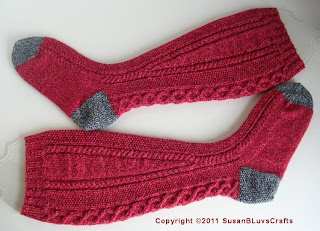During my year long hiatus from blogging, I continued knitting socks at my normal snail's pace, in bits and pieces while I worked on other projects. After I finished my toe-up Hermione's Everyday Socks, I almost immediately cast on a pair of knee socks.
A few years ago when I was still learning how much yarn a pair of knee socks needed, I found some lovely red Regia sock yarn. (I love red!) I bought three 50 gram skeins for a pair of knee socks. Then the Spring 2007 issue of Knitty magazine appeared with the Clessidra knee socks by designer Gabriella Chiarenza.
I decided my red Regia yarn should become Clessidra knee socks. Problem was the pattern calls for four 50 gram skeins. I was one skein short. I made a trip to Knit Wit in Olathe, Kansas in search of a fourth skein. The red was long gone, so I came home with a skein of black Regia yarn to use for the heels and toes.
I cast on my Clessidra knee socks on August 21, 2010 and finished them a mere 6 months later on February 21, 2011. I knitted magic loop style with 3 different sizes of needles. My size 6½ foot has an 8" circumference which is smaller than most pattern sizes, so I'm always modifying sock patterns to fit me. Additionally, I like to knit the feet at about 10 to 11 stitches per inch for comfort and better wear.
Clessidra is a pretty detailed pattern, which makes changing the stitch count challenging. Luckily, my calf is about the size the pattern is designed for, 14½", even though my foot is smaller than the pattern. I knit tightly, so I used 2.5 mm (size 1.5) needles to knit the upper leg at the pattern's 8 stitches per inch gauge.
I switched to 2.25 mm (size 1) needles 10 rounds past the last ankle decrease. This produced a close, comfortable fit on the lower leg. I switched to 2.0 mm (size 0) needles to get my preferred dense gauge on the heel flap and foot.
With my tight gauge, I wanted 76 stitches in the foot, instead of the pattern's 68. I didn't start the gusset with extra stitches, so I needed fewer decreases than the pattern used. I made my gusset decreases every 3 rows, instead of 2, so the gusset wouldn't be too short and tight across the top of my foot. I knitted the instep stitch pattern as written and added the 8 extra stitches to the sole of the sock.

The photo on the left shows the front of the Clessidra knee sock leg. It has a wide panel of seed stitch bordered by 2 narrow cables.

This photo shows the back of the sock leg. An hourglass cable is centered between 2 strips of seed stitch and it's all bordered by 2 more narrow cables.
The socks fit me very well. Using the black for the heels and toes, I had plenty of yarn. There was enough extra yarn, I could have easily knit the heels in the red yarn without running out.
I got lots of compliments on these socks from my knitting group at the library. Sandy jokingly called them "monkey socks," as in sock monkey socks, because of the black heels and toes. They are not monkey socks. They are much better!

WoW ! !
ReplyDeleteMajor, major undertaking.
No way you'd see me knitting these.
You've done a wonderfully beautiful piece of sock art.
Congrats ! ! !
hugs
Thank you, Gerry.
ReplyDeleteI kept close track of my row count to get the decreases in the right place.
The twists for the cables used 3 or 4 stitches, which are easy cables as long as you twist the right direction.
Thanks for visiting my blog and leaving a sweet comment, Susan.
ReplyDelete